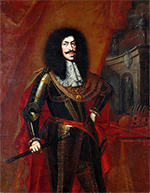Leopold I: Holy Roman Emperor, King in Germany
Leopold I was Holy Roman Emperor and King in Germany for a time during the last part of the 17th Century and the first few years of the 18th Century. His long reign included the prosecution of a handful of European wars. 
He was born on June 9, 1640, in Vienna. His father was the eventual Holy Roman Emperor Ferdinand III, and his mother was Maria Anna of Spain. A curious child and a good learner, Leopold studied liberal arts and also natural sciences and showed a particular interest and aptitude in music. He also developed fluency in a handful of languages, namely French, German, Italian, Latin, and Spanish. Leopold also studied religious matters, as was expected of a second-born son at that time. His older brother, Ferdinand, was the heir apparent and so underwent study and training consistent with a soon-to-be monarch. Indeed, their father became the emperor in 1637. In the next decade, as Ferdinand gained the crowns of Bohemia and Hungary, Leopold continued his religious studies and developed a piety that he would not shed. The Thirty Years War was raging at this time and had been for the better part of three decades. German lands, in particular, were laid waste. The war ended for most of the participants with the Peace of Westphalia, in 1648. Ferdinand III threw in his lot with Spain in its continued fight with France but otherwise tried to keep the peace within the Holy Roman Empire itself. The German states, meanwhile, set about rebuilding. The younger Ferdinand gained the throne of Germany, as King of the Romans, in 1653. He died the following year, however, and Leopold stepped into the role of heir apparent. He began collecting crowns in 1655, with the throne of Hungary; Bohemia and Croatia came next, in the following two years. Ferdinand III died in 1657, and Leopold became Holy Roman Emperor the following year, also becoming King in Germany by default. His ascension was not without controversy, as the powerful French Chief Minister Cardinal Mazarin had sought to keep the throne out of Habsburg hands. Leopold promised Mazarin that the empire would not ally with Spain, still fighting France even though the Thirty Years War had long ended. Hungary was a hotbed of intrigue under Leopold's reign, as the emperor tried to suppress a handful of Protestant uprisings. Nearby, an imperial victory at Vienna, in 1683, ended Ottoman expansion hopes for good. That was not the last time that the empire and France would quarrel. French aggression under Louis XIV eventually alienated many European states. Leopold allied himself with the Dutch Republic against France in 1672 and then, two years later, created the Quadruple Alliance by adding Spain and the Duchy of Lorraine. A 1678 treaty ended the fighting, but Louis XIV made serious gains. Fighting continued off and on for several years. Leopold in 1686 joined with the Dutch Republic and with England in the League of Augsburg, again to counter France. That grouping expanded to include Denmark and become the Grand Alliance, in 1689. Various bouts of fighting and peace alternated until the whole of Europe was consumed by the War of the Spanish Succession, which began in 1700. The imperial victory at Blenheim was scarcely a memory before Leopold died, on May 5, 1705. Leopold had married Margaret Theresa of Spain in 1666. They had four children; of those, only Maria Antonia (born 1669) lived into adulthood. Margaret Theresa died in 1673. Leopold married again later that same year, to Claudia Felicitas of Austria, and neither of their children lived long. She died in 1676, and Leopold married a third time, in that same year. They had 10 children, six of whom lived into adulthood: Joseph (1678), Maria Elisabeth (1680), Maria Anna (1683), Charles (1685), and Maria Magdalena (1689). |
|
Social Studies for Kids
copyright 2002–2025
David White




